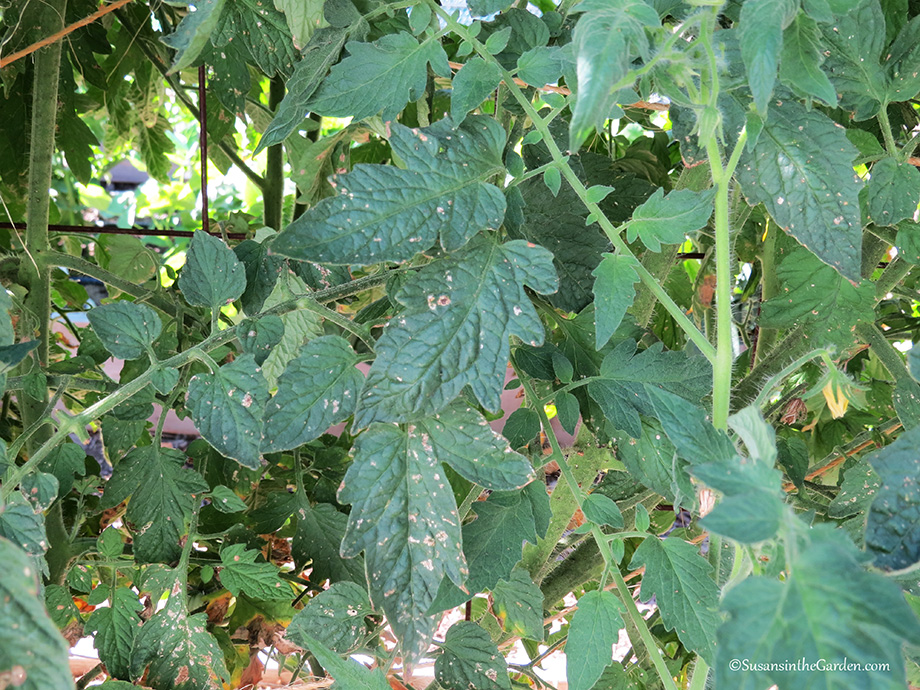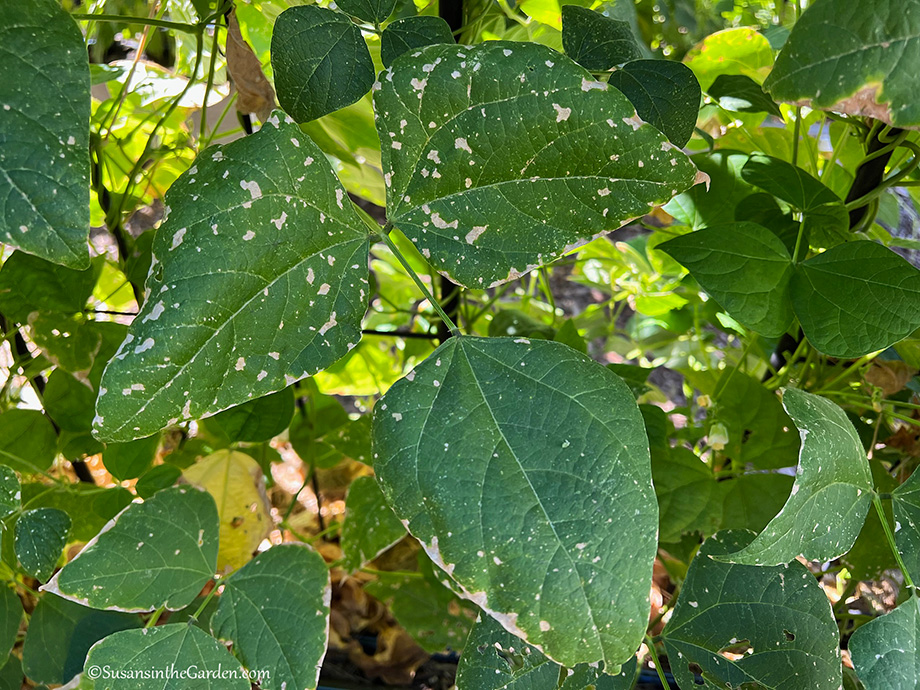Aug. 28 Column: Dealing with Thrips Insects

Are you familiar with the insects known as thrips? I got a big surprise in my garden this season: lots and lots of thrips damage. Ugh! That’s the topic of my garden column, which you can read in today’s edition of The Spokesman-Review: Thrips may be little but they are mighty damaging. Or you can read my column underneath the video below.
Did you know that the word “thrips” is both singular and plural? It’s true! You’ll learn about the damage they can cause and ways to control them.
You’ll notice there’s a photo of a bunch of tiny bugs at the very top of this post. Those are what thrips look like. They’re only 1/16″ long. I got that photo by trapping a bunch of them and then dumping them into a bucket of soapy water. And the two other photos illustrate what their damage looks like on tomato leaves (above) and pole bean leaves (below).
In this week’s video, I discuss tomato problems. First, I cover hornworms and thrips. Then I talk about some interesting and commonly-seen plant disorders. As I explain in the video, the latter are officially known as “physiological disorders” and are also called “abiotic disorders.” They are not caused by disease pathogens but rather, by either extreme weather or things we did or did not do to our plants. I think you’ll find it enlightening! (or at least, that was my hope, LOL)
Here’s my column:
by Susan Mulvihill
It was bad enough that our region’s cold, wet spring affected our tomato plants’ ability to produce a normal crop. When an unusual insect problem arose on them as well, I began taking it personally.
About 2 months ago, I started noticing small, light-colored specks on the lower leaves of the tomato plants. At the time, there wasn’t any serious damage so I didn’t feel the need to investigate further. It wasn’t long before the same signs appeared on our pole bean leaves.
When we gardeners see unusual damage on our plants but we don’t see insects, it can be easy to suspect a plant disease is the problem. Fortunately, I was able to use a magnifying glass and microscope to spot the culprits: thrips.
It’s likely you haven’t seen the thrips themselves in your garden because they are really tiny at just 1/16 inch long. Just like aphids, they have piercing/sucking mouthparts which they use to extract sap from plant foliage. These little insects possess fringed wings, have a striped abdomen and they range in color from yellow to brown to black.
There are multiple stages in the life cycle of thrips. The adults overwinter in plant debris. After mating, the females lay eggs within young plant foliage or flowers. The larvae hatch, feed and go through two stages called “instars.” They then drop down into the soil for two more instars, during which they grow wings and complete their transformation into adults.
Thrips are most commonly found on beans, peas, cucumbers, melons, pumpkins, squash, garlic, onions, peppers and tomatoes. In addition to stippled leaves, other signs of their damage are stunted plants, rolled leaves and scarred fruits. If you’ve ever noticed deformed rose buds, that’s also caused by thrips.
The good news is thrips have many natural predators such as big-eyed bugs, green lacewings, parasitic wasps, predatory thrips (yes, there are actually good thrips) and syrphid flies. The bad news is how plentiful they are, along with the fact that it’s so hard to see them. After doing a bit of research, I learned thrips tend to be more prevalent during hot, dry weather which certainly matches what we’ve been experiencing over the past couple of months.
How can you get rid of thrips? I wish there was a simple answer but they are so challenging. First and foremost, monitor your garden daily and inspect the crops listed above for damage. It’s possible to knock thrips off of plants by spraying them with a jet of water from the hose. You can also purchase or make blue sticky traps since thrips are attracted to that color; hang them near their host plants.
I’ve had good luck catching them inside sheets or rolls of corrugated cardboard. Lay your cardboard trap on the surface of a bed where thrips are causing trouble. The following morning, pick up the cardboard and tap it on the inside edge of a bucket that has been partially filled with water and a squirt of dish soap. You’ll soon see tiny bugs doing the backstroke.
If you’ve had significant problems with thrips on some of your crops, it’s a good idea to clean up plant debris at the end of the season so you won’t give the thrips a place to hide over the winter.
Organic products that will control thrips include diatomaceous earth, insecticidal soaps, neem, pyrethrins or spinosad. As always, follow the label directions.
Susan Mulvihill is author of “The Vegetable Garden Problem Solver Handbook” and “The Vegetable Garden Pest Handbook.” She can be reached at Susan@SusansintheGarden.com. Watch this week’s video at youtube.com/susansinthegarden.


